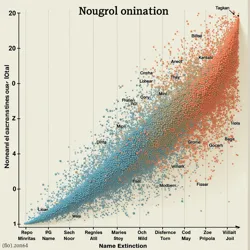Nominal Extinction
 Statistical analysis showing the rapid decline of multiple names across different cultures and time periods
Statistical analysis showing the rapid decline of multiple names across different cultures and time periodsNominal extinction refers to the phenomenon where previously common given names experience a dramatic decline in usage until they become extremely rare or disappear entirely from active use within a society. This process, distinct from natural naming pattern evolution, typically occurs due to specific cultural, historical, or sociological factors that render certain names socially undesirable or culturally inappropriate. The study of nominal extinction provides valuable insights into how societies process collective trauma, cultural change, and evolving social norms through naming practices.
Historical Development of the Concept
The systematic study of nominal extinction emerged in the mid-20th century, following observations of dramatic shifts in naming patterns after World War II. The field gained prominence through the work of Dr. Elena Rothschild's landmark 1952 study "The Death of Names," which documented the near-complete disappearance of certain Germanic names in post-war Europe. This research established the foundational principles of what would later be termed nominal extinction theory.
The concept builds upon earlier anthropological observations of naming taboos in traditional societies, where certain names would become forbidden following the death of prominent individuals or significant cultural upheavals. However, modern nominal extinction differs in its scale and rapidity, often affecting entire populations across national or linguistic boundaries within a single generation.
Mechanisms of Name Disappearance
The process of nominal extinction typically follows several distinct patterns, each influenced by different social and cultural factors. The most dramatic form, known as catastrophic name abandonment, occurs when names become strongly associated with traumatic historical events or deeply controversial figures. This pattern was notably observed with the name Adolf in German-speaking countries after World War II, where usage declined by over 99% within a single generation.
 Visualization demonstrating the correlation between major historical events and name extinction patterns
Visualization demonstrating the correlation between major historical events and name extinction patternsA more gradual form of nominal extinction occurs through what researchers term cultural drift extinction, where names slowly fade from use due to changing cultural preferences or demographic shifts. This process often affects traditional names that become viewed as outdated or disconnected from contemporary cultural values. The phenomenon has been particularly noticeable in increasingly multicultural societies, where traditional naming patterns may give way to more globally influenced choices.
Social and Psychological Factors
The psychological mechanisms underlying nominal extinction are complex and multifaceted. Research has shown that nominal avoidance often serves as a collective coping mechanism, allowing societies to distance themselves from traumatic events or negative associations. This process involves both conscious decision-making by parents and unconscious social pressures that influence naming choices.
The role of name stigmatization in driving nominal extinction has been extensively studied, particularly in cases where names become associated with negative stereotypes or cultural criticism. Modern social media and digital communication have accelerated this process, allowing negative associations to spread rapidly across cultural boundaries and geographic regions.
Contemporary Documentation Methods
Modern researchers employ sophisticated digital tools and statistical methods to track and analyze nominal extinction events in real-time. The field of computational onomastics has developed various metrics to measure the rate and extent of name disappearance, including the Name Extinction Index (NEI) and the Cultural Retention Factor (CRF).
These quantitative approaches have revealed patterns that were previously difficult to detect, such as the relationship between media coverage intensity and the rate of name abandonment. Research has shown that names featured prominently in negative news events often experience a measurable decline in popularity within months of the coverage peak.
Cultural Preservation and Resistance
Some communities have developed mechanisms to resist nominal extinction, particularly when it threatens names of cultural or historical significance. These efforts often involve cultural name preservation initiatives that document and promote traditional naming practices. Such programs frequently emphasize the historical and cultural context of names, attempting to separate them from negative modern associations.
The emergence of nominal resurrection movements has demonstrated that some names can recover from near-extinction, though this process typically requires sustained cultural effort and significant temporal distance from the original cause of decline. Successful examples of name rehabilitation often involve recontextualizing the name's historical significance or emphasizing positive cultural associations that predate the negative ones.
Global Implications and Future Trends
The acceleration of global communication and cultural exchange has led to new patterns in nominal extinction events. The digital name effect describes how online phenomena can rapidly influence naming choices across multiple cultures simultaneously, leading to coordinated patterns of name abandonment that were previously impossible.
Researchers have identified several factors that may influence future nominal extinction events, including:
- Increased global media interconnectedness
- Rising cultural sensitivity to problematic associations
- The rapid spread of social movements and cultural criticism
- Growing awareness of historical injustices and their linguistic legacies
Research Applications
The study of nominal extinction has practical applications beyond academic interest. Predictive naming analytics attempts to forecast potential name extinctions based on current cultural trends and social patterns. This research helps cultural institutions and communities prepare for and potentially mitigate the impact of rapid naming pattern changes.
Understanding nominal extinction patterns also provides valuable insights into broader social phenomena, including how societies process collective trauma, navigate cultural change, and maintain or abandon traditional practices in response to modernization pressures. These insights have applications in fields ranging from social psychology to cultural preservation policy.
See Also
- Regional Name Retention Effect
- Cross-cultural Naming Influence
- Nominal Heritage Movement
- Extinction Onomastics
References
The study of nominal extinction continues to evolve as new tools and methodologies emerge for tracking and analyzing naming patterns across cultures. As global communication continues to influence cultural practices, understanding these patterns becomes increasingly important for cultural historians, sociologists, and those working to preserve linguistic and cultural heritage.
 Documentation of traditional naming ceremonies as part of cultural preservation efforts
Documentation of traditional naming ceremonies as part of cultural preservation efforts